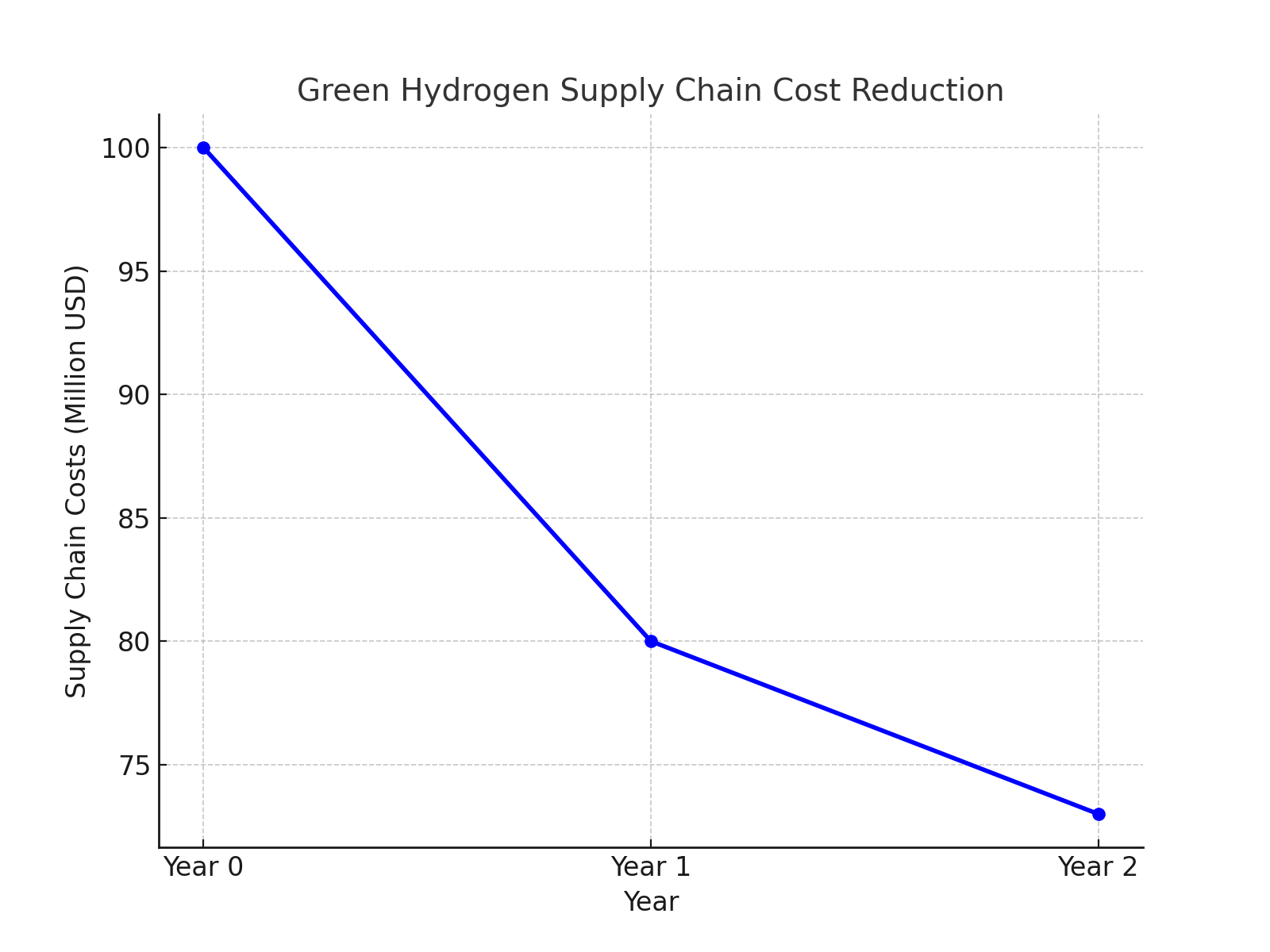Introduction
Green hydrogen is rapidly emerging as a critical component of the global energy transition, offering a zero-carbon alternative for hard-to-decarbonize sectors like steel, cement, chemicals, and heavy transportation. According to the International Energy Agency (IEA), the green hydrogen market could reach $300 billion by 2030, with production capacity expected to grow nearly tenfold.
Despite its potential, green hydrogen adoption faces significant operational and logistical challenges. Production is energy-intensive, requiring electrolysis powered by renewable energy. Transporting hydrogen is complex due to its low density, cryogenic requirements, and high-pressure storage needs. Additionally, fragmented supply chains, lack of traceability, and inefficiencies in logistics increase costs and limit scalability.
Our client, a Fortune 500 energy company, sought a comprehensive supply chain optimization strategy to reduce costs, enhance production efficiency, and secure industrial contracts in Europe and Asia-Pacific.
Challenges
-
High Production Costs:
Electrolyzers, while efficient in theory, often operated below optimal capacity due to fluctuating renewable electricity supply and maintenance constraints, leading to high per-unit production costs. -
Transport and Storage Complexity:
Hydrogen required cryogenic or high-pressure tank storage. Inefficient routing and partial truckloads increased costs by 15–20%. -
Lack of End-to-End Supply Chain Visibility:
Delays occurred due to poor coordination among production sites, logistics partners, and industrial consumers. -
Competitive Pressure:
Several competitors had already piloted large-scale projects. The client risked losing market share without a differentiated, cost-efficient solution. -
Regulatory Compliance:
Meeting international safety standards for hydrogen transport and storage was mandatory and required real-time tracking and traceability.
Solution: Digital-First Hydrogen Supply Chain
The consulting team implemented a multi-layered, technology-driven approach:
Phase 1: Blockchain-Enabled Traceability
-
Deployed a private blockchain network to record every batch of hydrogen from production to delivery.
-
Provided real-time tracking to ensure compliance with safety standards and quality assurance.
-
Enabled smart contracts for automated billing, reducing administrative overhead.
Phase 2: AI-Powered Logistics Optimization
-
Machine learning algorithms optimized transport routes, tank utilization, and load planning.
-
Forecasted demand at industrial facilities using historical consumption data and IoT-based sensors at client sites.
-
Reduced empty runs and inefficient routing, improving overall cost-efficiency.
Phase 3: Electrolyzer Performance Analytics
-
IoT sensors monitored temperature, pressure, and energy input in real-time.
-
AI models predicted maintenance needs and potential inefficiencies, increasing uptime by 18%.
-
Integrated with renewable energy forecasts to maximize electrolyzer operation during periods of excess solar/wind generation.
Phase 4: Strategic Industrial Partnerships
-
Established hydrogen hubs near steel mills, cement plants, and chemical factories.
-
Partnered with port operators for streamlined import/export logistics.
-
Negotiated joint ventures to secure long-term hydrogen off-take agreements.
Results Achieved
Within 24 months, the client achieved significant operational and commercial benefits:

-
27% Reduction in Supply Chain Costs: Optimized transport routes, improved tank utilization, and predictive maintenance drove cost efficiency.
-
35% Increase in Production Capacity: Electrolyzer uptime optimization and integration with renewable power allowed more consistent production.
-
Delivery Lead Time Reduction: Industrial clients now receive hydrogen shipments in 4 days instead of 12, improving project reliability.
-
$1.2 Billion in New Contracts: Industrial clients were attracted by reliable supply and transparent tracking, increasing off-take agreements.
-
Enhanced ESG Compliance: Blockchain traceability and efficient transport lowered carbon footprint, aligning with sustainability goals.
Competitive Benchmarking
| Approach | Cost Efficiency | Delivery Time | Production Uptime | Customer Confidence |
|---|---|---|---|---|
| Traditional Supply Chain | Moderate | Long | 80% | Moderate |
| Semi-Digital Optimization | Good | Moderate | 85% | Good |
| Full AI + Blockchain Solution (Client) | Excellent | Short | 95% | High |
The client emerged as a leader in green hydrogen supply chain innovation, surpassing competitors in cost, reliability, and scalability.
Strategic Insights
-
Blockchain Ensures Trust and Compliance: Real-time traceability reduces risk, builds customer confidence, and streamlines regulatory reporting.
-
AI Enables Predictive Optimization: Optimizing routes, storage, and electrolyzer performance maximizes efficiency and reduces costs.
-
Strategic Hubs Reduce Lead Times: Locating production near consumption points accelerates delivery and mitigates transport risks.
-
Sustainability Drives Market Advantage: Clients increasingly prioritize suppliers with low carbon footprints and transparent operations.
-
Future-Proof Supply Chain: Digitally integrated hydrogen supply chains are scalable, adaptable, and resilient against market fluctuations.
Future Outlook
-
Expansion of hydrogen corridors linking Europe, Asia-Pacific, and North America.
-
Integration of autonomous hydrogen transport vehicles and smart logistics systems.
-
Development of dynamic pricing models using AI to optimize supply-demand economics.
-
Scaling to industrial microgrids powered by hydrogen and renewable energy sources.